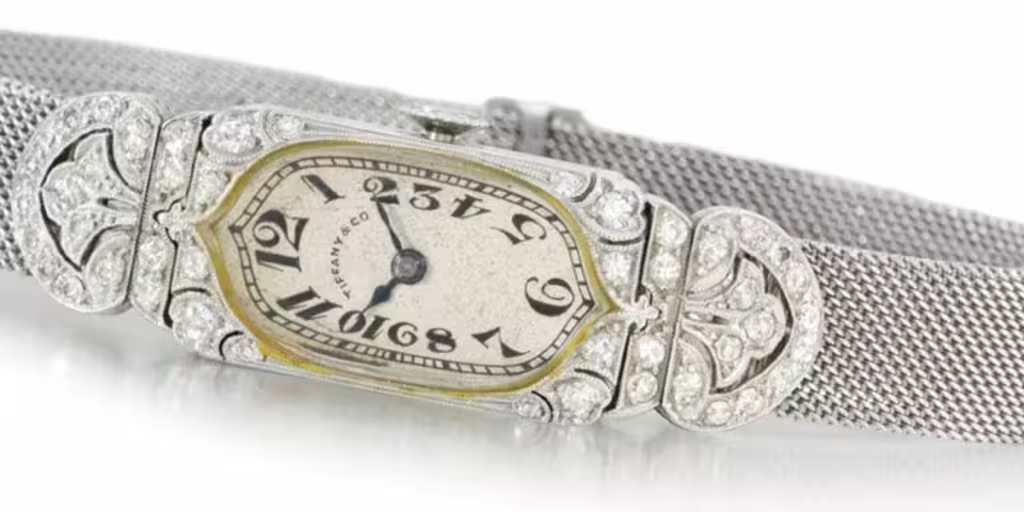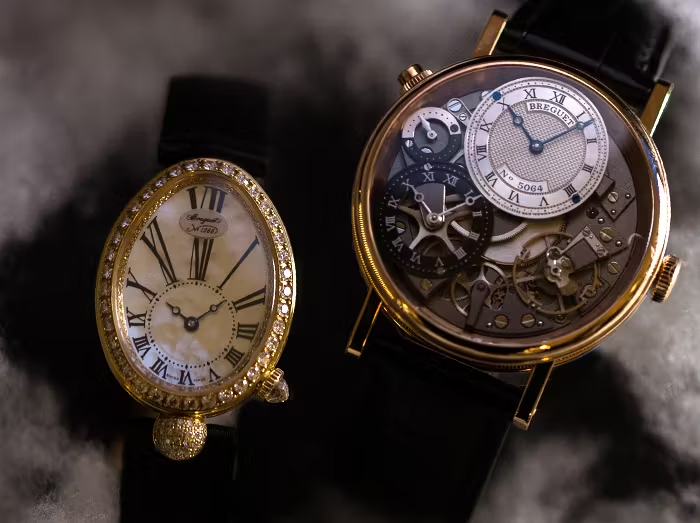Introduction
The wristwatch is accessories we wear everyday in order not to forget our time and in order to look good at the same time. A common item of jewellery today, in the past the wristwatch has a very complex and fascinating history. From aristocrats and military officers to mass production for civilians, it has had a story to tell. Yet, where did this story start? When was the first wristwatch invented, and who wore it?
This article chronicles the first wristwatches we know of, their genesis, how they first came to be worn on the wrist, and how they initially served as status symbols for the elite, before expanding to become the all-important accessory common to virtually every aspect of civilised life today.
Pocket Watches and the Shift Towards the Wrist
Pocket watches were the prior mainstream way to keep time before the wristwatch, and they were especially popular in the 17th and 18th centuries. Tucked into pockets, often attached with chains and pendants, aristocrats, merchants and explorers used them to keep their timepieces at the ready and maintained their schedules. But these types of clockwork and spring-driven watches had inconveniently positioned faces, especially in situations in which a hands-free timekeeping device was required, such as in warfare and travel.
This watch was available thanks to the need to know the time on the move.
Who Made the First Wristwatch?
There are two major accounts of the first-ever wristwatch:
Abraham-Louis Breguet for Caroline Murat (1810)
Patek Philippe for Countess Koscowicz (1868)
Let’s explore both claims.
1. Breguet and the First Wristwatch for Caroline Murat (1810)
The first known wristwatch was made in 1810 for Caroline Murat, Queen of Naples and the sister of Napoleon Bonaparte, by none other than Abraham-Louis Breguet, considered the inventor of the tourbillon and one of the most famous watchmakers of all time. Murat, who had an extravagant reputation, requested an enchanting piece of jewellery that would combine practicality and beauty.
Murat’s wristwatch was an oval and open-faced timepiece, worn on a bracelet to be kept handy at all times. Such a wristwatch was conceived as an alternative to the pocket watches of the time and was one of the first precursors of the modern-day wristwatch.
Unfortunately, the prototype never made it into production and the original does not survive. All we have is the sketch, and evidence from historical writings. The Breguet was the first deliberate, concerted attempt at a wrist timekeeping device.
2. Patek Philippe and the Countess Koscowicz (1868)
Another strong candidate for ‘first wristwatch’ is the clock that the Swiss watch firm Patek Philippe produced in 1868 to sell to the Hungarian countess Koscowicz.
Patek Philippe’s, a floral bracelet with an integrated mechanical watch. Both were jewelled bracelets that concealed a watch, and they both incorporated some of the advances associated with the earlier Breguet piece: they were meant to be worn on the wrist and serve both as adornment and timekeeping instrument.
Then, for a man, wristwatches still seemed more like a women’s accessory, while pocket watches prevailed among gentlemen – a wristwatch, in his eyes, was considered neither particularly functional nor manly.
Military Use and the Popularization of Wristwatches
As a fashion accessory for women, the first wristwatches were a passing fancy. But the second coming of the wristwatch happened when military need pushed the technology into the mainstream – and men’s wardrobes. Beginning in the late 19th and early 20th centuries, armies needed a way to quickly check the time hands-free as they manoeuvred troops and weaponry on the battlefield.
Arguably, one of the very first military uses of wristwatches can be found with soldiers from the British Army who, while fighting in the Second Boer War (1899-1902), wore relatively unwieldy timepieces strapped to their wrists, regularly with a modified pocket watch connected to the wrist with a right-angle strap made of leather.
The shift was catalysed by the First World War (1914-1918). Officers and soldiers depended on wristwatches for synchronising their attacks, timing their artillery and keeping pace with the schedule of their battle plans. Known as ‘trench watches’ during this period, these timepieces came equipped with luminescent dials as well as guards to shelter their mechanisms from wind and mud.
However, during the First World War, the need for coordination on the battlefield solidified the utility of the wristwearable. When the war ended on 11 November 1918, men’s wristwatches were heading steadily towards becoming a part of the male sartorial uniform.
In that sense, they had travelled a far different path than women’s pocket watches had. Originally reserved for the occasional status symbol, the wristwatch was now a sequential and mass trend. If Dutch Prince Hendrik had once strapped one on with the foresight of a visionary, it was now worn in much the same way as any other piece of clothing.
Rolex and the Innovation of the Waterproof Wristwatch
As wristwatches became ever more popular, rapid innovation became a constant. Perhaps the most important of all advances in the early days of wristwatches was the Rolex Oyster of 1926. The first waterproof wristwatch, as the name suggests, its components were lightly sealed together with an airtight caseback to stave off the dust, moisture and water that ordinary pocket watches weren’t built to withstand.
Rolex added to this by securing the ownership of the wristwatch in the chronicle of human accomplishment. In 1927, the endurance swimmer Mercedes Gleitze crossed the English Channel while wearing a Rolex Oyster.

The Rise of Mass Production and Quartz Watches
By the end of the 20th century, wristwatches had become everyday necessities, often replacing ladies’ necklaces. Mechanical mass-production capabilities produced watches for a wider audience: watch manufacturers such as Seiko and Timex made affordable watches suitable for the masses.
In 1969, Seiko released the world’s first quartz wristwatch: the Seiko Astron. Extremely accurate, requiring little maintenance, quartz watches soon took the world by storm.
They were also much cheaper than their mechanical counterparts, and this led to the so-called ‘Quartz Revolution’ (or ‘Quartz Crisis’), during which many of the old-fashioned Swiss watch manufacturers were forced to adapt to the new reality, struggling to compete against the rising popularity of quartz timepieces.
Wristwatches were fitted with quartz movements from the early 1970s onwards – a trend that became the norm for the sector throughout the 1970s and ’80s. This led to a new golden age for watchmaking, and made it more high-tech than ever.
Smartwatches: The Modern Evolution of Wristwatches
Nowadays, the smartwatch became a popular object. Many companies such as apple, Samsung, Garmin has innovated the wristwatch such as digital watches that includes fitness tracking, heart rate monitoring, and GPS navigation.
When it entered the market in 2015, the Apple Watch empowered wristwatches to serve as powerful wearable computers that allowed users to interact with their bodies in previously unimaginable ways. Smartwatches don’t merely tell time, but instead function as miniature extensions of our smartphones that provide notifications, reminders and, perhaps most importantly, help manage people’s lives and health.
Contrary to the growing popularity of the smartwatch, the good old mechanical wristwatch hasn’t lost its lustre. High-end brands such as Rolex, Omega and Patek Philippe have healthy business, despite strong competition.
Conclusion
The first wristwatch was not just a time-telling device. It was the beginning of what would become a marriage of necessity and style. The earliest watches measured 50mm in diameter and were created by men such as Abraham-Louis Breguet, who made a wristwatch for Queen Caroline Murat of Naples in 1810, or Patek Philippe, which devised a model for Countess Koscowicz in 1868. Throughout the 19th century, military need and technological advances determined the future of this future piece of jewellery.
Whether quartz movements, top-shelf mechanical watches, or digital smartwatches, we still wear the gadget on our wrists because it combines practicality with personal style. The little watch on my wrist tells the big story, and goes to show you that some ideas are just good ones, and that good ideas generally get better with time.
Likewise, as the wristwatch marches on into the future, it will continue to be a magnifying glass onto its past – an ornament, an innovation and a tool for life, always coloured by contemporary desires and necessities.

